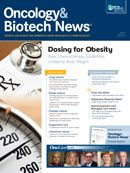Publication
Article
Lapatinib Plus Trastuzumab Bests Lapatinib Monotherapy in HER2-Positive Metastatic Breast Cancer
Author(s):
Investigators have documented a significant 4.5-month median overall survival advantage with lapatinib combined with trastuzumab in women with heavily pretreated HER2-positive metastatic breast cancer.
Kimberly L. Blackwell, MD
Investigators have documented a significant 4.5-month median overall survival (OS) advantage with lapatinib combined with trastuzumab versus lapatinib monotherapy in women with heavily pretreated HER2-positive metastatic breast cancer.
The findings come from an update of the phase III EGF104900 study, which had found in an earlier analysis that combination therapy significantly improved progression-free survival (PFS), the primary endpoint (hazard ratio [HR] = 0.73; 95% CI, 0.57-0.93; P = .008), versus lapatinib alone.
Overall, the data bolster the hypothesis that combining anti-HER2 agents “may optimize their use,” Kimberly L. Blackwell, MD, professor of medicine and assistant professor of Radiation Oncology at Duke University Medical Center in Durham, North Carolina, and coauthors wrote.
The updated analysis is based on data from January 2009 and includes all 291 patients with HER2- positive metastatic breast cancer who were randomized to lapatinib in tandem with trastuzumab or lapatinib alone after their disease had progressed during prior trastuzumab-based therapies. The earlier PFS results were drawn from data available in June 2007.
The updated analysis found that lapatinib plus trastuzumab continued to demonstrate superiority to lapatinib monotherapy in investigator-assessed PFS (HR = 0.74; 95% CI, 0.58- 0.94; P = .011). Additionally, the median OS was 14 months for combination therapy and 9.5 months for lapatinib alone (HR, 0.74; 95% CI, 0.57-0.97; P = .026).
The data also showed a 10% improvement in absolute OS rate at 6 months and a 15% improvement at 12 months in the combination arm versus the monotherapy group.
Overall, 94% of patients who received combination therapy and 90% of patients who received monotherapy experienced adverse events.
Baseline factors associated with improved OS included ECOG performance status of 0, nonvisceral disease, fewer than three metastatic sites, and shorter time between initial diagnosis and randomization.
Blackwell et al noted that their findings corroborate preclinical data indicating that the lapatinib plus trastuzumab combination has synergistic antiproliferative activity.
They also emphasized that “clinically relevant” OS improvement occurred even though more than half of women who were initially randomized to lapatinib monotherapy switched to combination therapy upon disease progression.
Finally, the authors noted that the median 4.5-month survival advantage is on par with improvements that have been reported when trastuzumab is added to chemotherapy as frontline treatment for HER2-positive metastatic breast cancer. “Although the optimal setting for combining anti-HER2 agents is unknown, this strategy seems beneficial and may allow patients to omit chemotherapy for a period of time,” the researchers noted.
Blackwell KL, Burstein HJ, Storniolo AM, et al. Overall survival benefit with lapatinib in combination with trastuzumab for patients with human epidermal growth factor receptor 2-positive metastatic breast cancer: final results from the EGF104900 study. J Clin Oncol. 2012;30(21):2585-2592.









